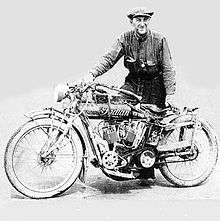Erwin Baker

Erwin George "Cannon Ball" Baker (March 12, 1882 – May 10, 1960) was an American motorcycle and automobile racing driver and organizer in the first half of the 20th century. Baker began his public career as a vaudeville performer, but turned to driving and racing after winning a dirt-track motorcycle race in Crawfordsville, Indiana in about 1904.
Baker was also famous for his record-setting point-to-point drives, in which he was paid to promote the products of various motorcycle and automobile manufacturers. In all, he made 143 cross-country motorcycle speed runs totaling about 550,000 miles (890,000 km).
In 1908, Baker purchased an Indian motorcycle and began entering and winning local races. His most famous victory came in 1909 at the first race ever held at the newly built Indianapolis Motor Speedway. Baker also raced at the 1922 Indianapolis 500, placing 11th in a Frontenac. He later became the first commissioner of NASCAR. Baker was inducted into the American Motorcyclist Association Motorcycle Hall of Fame in 1998.
Life
Baker was born in Dearborn County, Indiana, in 1882. In January 1912 he left Indianapolis on a two-speed Indian and covered 14,000 miles in three months, traveling through Florida, down to Cuba and Jamaica, and then to Panama.[1][2] He took a steamer up to San Diego where he based himself for a while and from there he competed in several endurance runs in both California and Arizona. It was during this time that Baker decided he would attempt to break the transcontinental record. After a record-setting transcontinental drive in 1914, he received his nickname "Cannon Ball" from a New York newspaper writer who compared him to the Cannonball train of the Illinois Central made famous by Casey Jones.[3]
Records
Baker set 143 driving records from the 1910s through the 1930s. His first was set in 1914, riding coast to coast on an Indian motorcycle in 11 days. He normally rode to sponsor manufacturers, guaranteeing them "no record, no money".
In 1915, Baker drove from Los Angeles to New York City in 11 days, 7 hours and fifteen minutes in a Stutz Bearcat, and the following year drove a Cadillac 8 roadster from Los Angeles to Times Square in seven days, eleven hours and fifty-two minutes while accompanied by an Indianapolis newspaper reporter. In 1924 he made his first midwinter transcontinental run in a stock Gardner sedan at a time of 4 days, 14 hours and 15 minutes. He was so impressed by the car, that he purchased one thereafter.[4] In 1926 he drove a loaded two-ton truck from New York to San Francisco in a record five days, seventeen hours and thirty minutes, and in 1928, he beat the 20th Century Limited train from New York to Chicago. Also in 1928, he competed in the Mount Washington Hillclimb Auto Race, and set a record time of 14:49.6 seconds, driving a Franklin.[5]
His best-remembered drive was a 1933 New York City to Los Angeles trek in a Graham-Paige model 57 Blue Streak 8, setting a 53.5 hour record that stood for nearly 40 years. This drive inspired the later Cannonball Baker Sea-To-Shining-Sea Memorial Trophy Dash, better known as the "Cannonball Run", which itself inspired at least five movies and a television series. In 1941, he drove a new Crosley Covered Wagon across the nation in a troublefree 6,517-mile (10,488 km) run to prove the economy and reliability characteristics of Crosley automobiles. Other record and near-record transcontinental trips were made in Model T Fords, Chrysler Imperials, Marmons, Falcon-Knights and Columbia Tigers, among others.
Death
Baker died of a heart attack at Community Hospital in Indianapolis, Indiana on May 10, 1960 at age 78. He is buried at Crown Hill Cemetery in Indianapolis.[6]
Indy 500 results
|
| |||||||||||||||||||||||||||||||||||||||||
See also
References
- Brock Yates (2003). Cannonball! World's Greatest Outlaw Road Race. Motorbooks International. ISBN 0-7603-1633-3.
- ↑ "Cannon Ball" (PDF), 2008 Indianapolis 500 flyer, Indianapolis Motor Speedway, p. 192, 2008
- ↑ "Cannon Ball Baker", Hemmings Classic Car, July 2013
- ↑ "AMA Motorcycle Hall of Fame: Erwin 'Cannonball' Baker". Motorcycle Hall of Fame. Pickerington, OH USA: American Motorcyclist Association. Retrieved 2011-10-22.
- ↑ http://www.gardnermotorcars.com/cb-run.html
- ↑ The Climb to the Clouds Vintage Hillclimb at the Mt. Washington Auto Road at the base of Mt. Washington, Pinkham Notch New Hampshire
- ↑ "Indianapolis Auto greats" (PDF). Celebrating Automotive Heritage at Crown Hill Cemetery. Crown Hill Cemetery. 2011. Retrieved 2012-09-10.